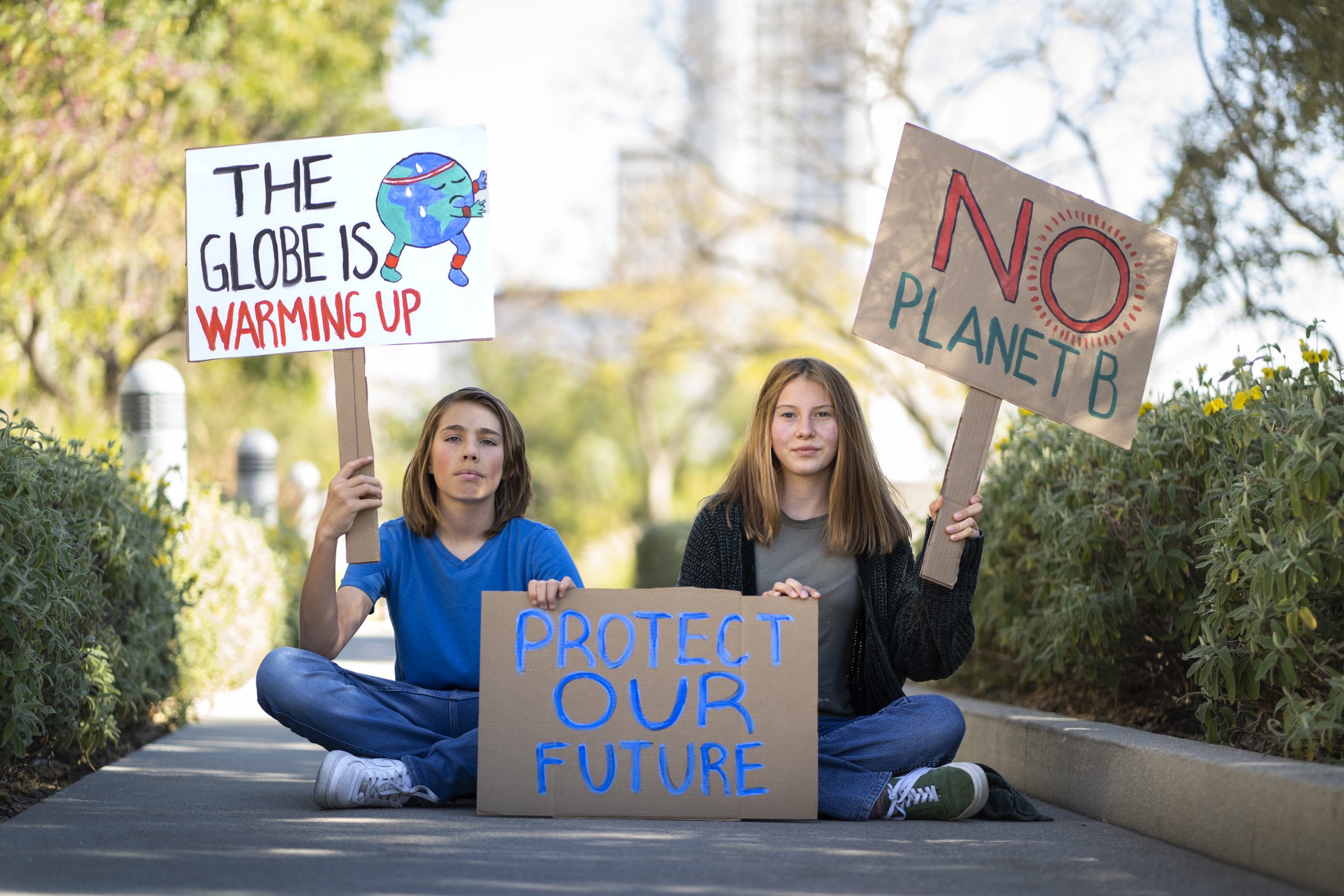The fashion industry is a significant contributor to environmental degradation. As one of the largest polluting industries, fashion is responsible for 10 percent of global carbon emissions, driven by unsustainable production processes, excessive water usage, and the massive textile waste generated. How is the industry addressing this alarming environmental crisis?

Per the UN Environment Programme, the fashion industry is the second-biggest consumer of water and is responsible for about 10 percent of global carbon emissions — more than all international flights and maritime shipping combined. Unfortunately, the industry’s problems are often overlooked by consumers.
Fast fashion, with its rapid production cycles and disposable culture, amplifies the climate crisis with overconsumption, contributing to the landfill overflow of tonnes of discarded clothes. The production of synthetic fabrics like polyester—derived from fossil fuels—releases micro-plastics into waterways and damages the ecosystem. Dyeing processes alone account for 20 percent of industrial water pollution: a grim reminder of the industry’s environmental footprint.
In response to this growing crisis, many fashion brands are acknowledging their role in climate change and are taking steps toward sustainability. Patagonia and Stella McCartney champion eco-conscious practices, using organic and recycled materials. The Fashion Pact, a coalition of global fashion companies, was launched to reduce the fashion industry’s carbon footprint, pledging to meet targets for reducing greenhouse gas emissions, water use, and textile waste.
However, the fashion industry’s response remains fragmented, with several brands and retailers prioritising profit over sustainability. As the urgency to combat climate change escalates, it is clear that the industry must overhaul its production processes, shift towards a circular economy, and make bolder commitments to eco-friendly practices if it is to play a meaningful role in reducing its environmental impact.
The clock is ticking and the need for action has never been more critical. Let’s take a closer look!
Fast Fashion’s Environmental Impact
The detrimental impact of fast fashion waste is a significant environmental concern. The fashion industry is responsible for app. 10 percent of global carbon emissions, per earth.org. ‘Of the 100 billion garments produced each year, 92 million tonnes end up in landfills. To put things in perspective, this means that the equivalent of a rubbish truck full of clothes ends up on landfill sites every second. If the trend continues, the number of fast fashion waste is expected to soar up to 134 million tonnes a year by the end of the decade.’
The environmental impact of fast fashion is further exacerbated by the textile production process. Dyeing and finishing processes are responsible for ‘3% of global CO2 emissions as well as over 20% of global water pollution’, per earth.org. The use of toxic chemicals in these processes leads to the contamination of water sources, affecting ecosystems. Moreover, the combination of synthetic and natural fibers complicates recycling efforts, as these materials are challenging to separate and process, leading to increased landfill waste. If no action is taken to reduce fast fashion waste, the fashion industry’s global emissions will likely double by the end of the decade.
Companies like Shein, Zara, H&M, and Uniqlo face criticism for their unsustainable practices. For instance, Shein’s rapid production model and reliance on synthetic materials have led to significant carbon emissions and micro-plastic pollution. Zara and H&M have been scrutinised for their high turnover of collections and use of non-biodegradable materials, which contribute to textile waste and environmental harm
The environmental cost of textile production, dyeing and waste is staggering. The fashion industry generates 92 million tonnes of textile waste annually, with much of it ending up in landfills or being incinerated. This waste occupies landfill space and releases harmful chemicals into the environment as the materials decompose. The combination of overproduction, excessive water usage, and pollution from dyeing processes underscores the urgent need for a shift towards sustainable practices in the fashion industry.
What are the fast fashion brands doing about it? H&M started the non-profit H&M Foundation in 2014 to improve environmental issues in the industry. It was initiated — as the foundation states on its website — ‘to co-create, fund and share solutions for the world’s most urgent challenges’ by promoting a ‘planet positive fashion future’. One of its core projects is promoting innovative technologies to recycle clothes. The most prominent example is the foundation’s partnership with the Hong Kong Research Institute of Textiles and Apparel, the world’s first facility to turn recycled fabrics into new clothes.
How Can We, the Consumer, Reduce Landfill Waste?
- Instead of purchasing beverages in single-use plastic bottles, choose reusable containers.
- Cut back on over-consumption: the fewer products we purchase, the less waste we produce.
- Reusing things reduces waste and conserves natural resources.
- Invest in products that use recycled materials to contribute to environmental improvement.
- Greener, natural cleaning agents like vinegar and baking soda reduce waste produced by the countless cleaning product containers and are better for the environment.
- Adopt recycling processes and pre-loved items to minimise waste.
- Compost a significant amount of waste to help with the broader landfill crisis.
- Lower solid waste in discussion with other residents of the neighbourhood and learn more about the garbage and recycling policies that the entire community has in place.
- Make a difference and set an example for others to follow.
Sustainable Fashion: A Growing Movement
A growing number of fashion brands are putting sustainability into practice, from supporting artisanal production and upcycling deadstock to harnessing cutting-edge technology throughout the entire process from design to production and packaging. In fact, between half to two-thirds of shoppers would pay more for sustainable products, per the National Retail Federation.
Sustainable fabrics offer eco-friendly alternatives to conventional materials. Organic cotton, for instance, is cultivated without synthetic pesticides or fertilisers, promoting soil health and reducing water consumption. Similarly, hemp is a fast-growing plant that requires minimal water and no pesticides, producing durable textiles recognised for their strength and natural resistance to mold and UV rays. Tencel, or lyocell, is another sustainable option, made from wood pulp through a closed-loop process that recycles water and solvents, resulting in biodegradable and breathable fabrics.
The adoption of closed-loop systems and circular economy principles is gaining momentum. This approach minimises waste and maximises the reuse of materials. For example, brands like Zara are collaborating with companies like Circ to launch collections made from recycled textile waste, transforming polyester-cotton blends into new garments. Similarly, MUD Jeans offers a leasing model for denim, allowing customers to return old jeans for recycling or upcycling, subsequently promoting a circular lifecycle for their products.
Several fashion brands are leading the charge in sustainable practices. Patagonia utilizes recycled materials, organic cotton, and responsibly sourced down in their products, emphasising durability and environmental responsibility. Stella McCartney is a pioneer in luxury sustainable fashion, showcasing collections made from innovative materials like FEVVERS, a plant-based feather alternative, and PURE.TECH, a fabric designed to absorb air pollutants AP News. French footwear brand Veja emphasises transparency in its supply chain, using organic cotton and wild rubber sourced from native tappers, and compensating them for both the raw material and conservation of the ecosystem.
Emerging designers are making contributions to sustainable fashion. Lucy Tammam’s label, Tammam, produces haute couture using sustainable materials like organic cotton and Tencel, and incorporates handcraft techniques. Her “One Dress: Planet” project launched this year features an evening gown made from sustainable materials and embroidered with flora from endangered ecosystems. Additionally, Indian fashion brands Lovebirds and Doodlage are embracing circular fashion initiatives, using eco-friendly fabrics and upcycling textile waste.
These efforts highlight a growing movement in the industry towards sustainability, demonstrating that style and environmental responsibility go hand in hand. By embracing sustainable fabrics, closed-loop systems, and ethical manufacturing practices, both established and emerging brands can pave the way for a more sustainable and conscious fashion future.
The Role Of Technology In Reducing Fashion’s Carbon Footprint
The rise of 3D printing, AI design and digital fashion mitigate fashion’s environmental impact. 3D printing technology allows the creation of garments with minimal waste. By reducing fabric off-cuts and waste from traditional garment production, 3D printing presents a sustainable way to create clothing. Additionally, AI design helps optimize patterns and material usage, reducing excess production and ensuring that fashion is mindful of resources. These technologies also make it easier to create bespoke items that can be tailored to individual measurements, preventing overproduction.
Incorporating biodegradable materials into fashion design further supports sustainability. Natural fibres like organic cotton and hemp are being developed alongside bio-based alternatives, such as mushroom leather or algae fabrics, which degrade naturally without contributing to the landfill crisis. Combined with energy-efficient production processes, these materials create a sustainable production cycle. The use of renewable energy sources in textile production is also gaining traction, helping fashion houses reduce their carbon footprint and adopt more eco-friendly practices. By leveraging these advancements, the industry can shift away from synthetic fibres and toxic chemicals, aligning with broader efforts to reduce environmental harm.
The concept of Circular Fashion is central to the shift towards a more sustainable industry, and digitalisation plays a vital role in its evolution. With digital fashion, it is possible to create virtual garments that eliminate the need for physical production. These digital designs allow consumers to experiment with fashion without purchasing new clothes, helping to reduce waste from fast fashion.
Moreover, digitalisation enables the creation of platforms for virtual try-ons and digital collections that eliminate the need for shipping and production. As the market for virtual fashion continues to grow, its positive impact on the planet will become increasingly significant, contributing to a more circular economy.
Consumer Awareness and Behavior Change

The rise of second-hand shopping, vintage fashion and slow fashion movement has significantly contributed to mitigating the fashion industry’s environmental impact. Embracing second-hand fashion reduces climate change impact and energy demand by up to 42%, and decreases water scarcity footprints by up to 53% per Journal of Circular Economy.
Additionally, purchasing vintage fashion helps divert textile waste from landfills, conserving resources and reducing carbon emissions. In New South Wales, Australia, second-hand shopping saved $432 million and diverted 107 million items from landfills in 2022-23, reducing carbon dioxide emissions by 321,000 tonnes.
The slow fashion movement complements these efforts by promoting sustainable consumption patterns. By emphasising quality over quantity and encouraging consumers to invest in few durable pieces, slow fashion reduces the demand for fast fashion’s resource-intensive, fast production cycles. This approach curbs overconsumption and fosters a culture of mindfulness.
Industry Collaboration for Climate Action
The fashion industry has recognised the need for collective action to address climate change. A notable initiative is the Fashion Pact, launched in 2019 at the G7 summit. This coalition of over sixty fashion brands, including Kering, LVMH, and Adidas, aims to tackle climate change by focusing on three key areas: reducing global warming, restoring biodiversity, and protecting oceans. Members of the Fashion Pact are committed to sustainability in their operations, including implementing carbon reduction strategies, sourcing sustainable materials, and committing to circular production models. This partnership highlights the power of industry collaboration, bringing together diverse players to address systemic environmental challenges.
Another significant collaboration is the UN Fashion Industry Charter for Climate Action, which was created in 2018 in response to the urgent need for the fashion sector to reduce its carbon footprint. The Charter brings together brands, retailers, and other stakeholders to commit to ambitious climate targets, including reaching net-zero emissions by 2050. The Charter focuses on different aspects of the fashion supply chain, from design and production to retail and disposal. Signatories pledge to adopt strategies that reduce their emissions, such as using renewable energy, optimising logistics, and promoting circular economies. This initiative promotes climate action and requires signatories to align their sustainability efforts with science-based targets and report their progress.
Both collaborations illustrate that addressing climate change requires collective effort, particularly in an industry that is resource-intensive and influential. Governments play a role in fostering these partnerships, providing the regulatory frameworks and incentives that support sustainable fashion practices. For instance, the European Union Green Deal and national policies are offering financial support for sustainable initiatives. These collaborations between fashion brands, organizations, and governments are creating a foundation for a more sustainable and environmentally responsible fashion industry, ultimately driving the sector toward a future where environmental considerations are at the heart of business decisions.

Quick Facts: Environmental statistics related to fashion’s carbon footprint
- Global Carbon Emissions
The fashion industry contributes approximately 10% of global carbon emissions annually, surpassing the combined emissions from international flights and maritime shipping.
- Textile Waste
Around 85% of textiles produced each year end up in landfills or are incinerated, contributing to significant environmental pollution.
- Microfiber Pollution
Washing synthetic garments releases about 500,000 tons of microfibres into the ocean annually, equivalent to 50 billion plastic bottles.
- Water Consumption
The fashion industry consumes approximately 215 trillion liters of water annually, equivalent to 86 million Olympic-sized swimming pools.
- Methane Emissions
Animal-derived materials like wool and leather, representing 3.8% of the apparel market, account for 75% of the fashion industry’s methane emissions, totaling about 8.3 million metric tons annually.

Jasmeen Dugal is Associate Editor at FashionABC, contributing her insights on fashion, technology, and sustainability. She brings with herself more than two decades of editorial experience, working for national newspapers and luxury magazines in India.
Jasmeen Dugal has worked with exchange4media as a senior writer contributing articles on the country’s advertising and marketing movements, and then with Condenast India as Net Editor where she helmed Vogue India’s official website in terms of design, layout and daily content. Besides this, she is also an entrepreneur running her own luxury portal, Explosivefashion, which highlights the latest in luxury fashion and hospitality.












